ASUS PN50 mini-PC Review: A Zen 2 Business NUC
by Ganesh T S on October 1, 2021 10:00 AM EST- Posted in
- Systems
- AMD
- Asus
- NUC
- UCFF
- Mini-PC
- Zen 2
- Ryzen Embedded
- Renoir
- Ryzen 4000
- Ryzen 7 4800U
BAPCo SYSmark 25
The Asus PN50 was evaluated using our Fall 2018 test suite for small-form factor PCs. The test suite includes BAPCo's SYSmark 25 - an application-based benchmark that uses real-world applications to replay usage patterns of business users in the areas of productivity, creativity, and responsiveness. The 'Productivity Scenario' covers office-centric activities including word processing, spreadsheet usage, financial analysis, software development, application installation, file compression, and e-mail management. The 'Creativity Scenario' represents media-centric activities such as digital photo processing, AI and ML for face recognition in photos and videos for the purpose of content creation, etc. The 'Responsiveness Scenario' evaluates the ability of the system to react in a quick manner to user inputs in areas such as application and file launches, web browsing, and multi-tasking.
Scores are meant to be compared against a reference desktop (the SYSmark 25 calibration system, a Lenovo Thinkcenter M720q with a Core i5-8500T and 8GB of DDR4 memory to go with a 256GB M.2 NVMe SSD). The calibration system scores approximately 1000 in each of the scenarios. A score of, say, 2000, would imply that the system under test is twice as fast as the reference system.
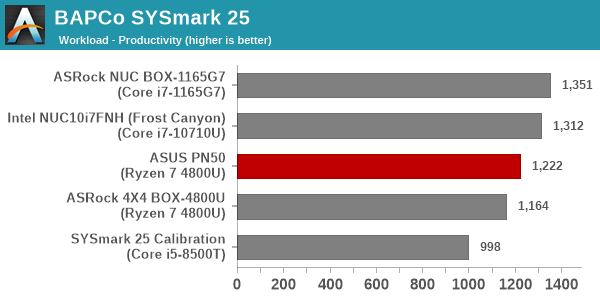

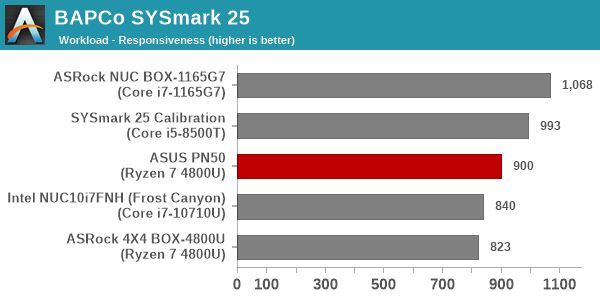
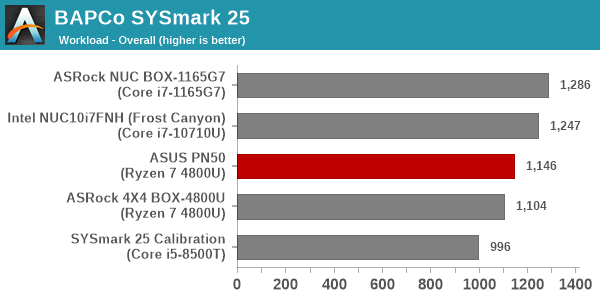
The mix of workloads in SYSmark 25 puts more emphasis on single-threaded performance, and it is no surprise that the Tiger Lake NUC BOX-1165G7 and the Frost Canyon NUC outscore the ASUS PN50. Between the PN50 and the 4X4 BOX-4800U, the ASUS system has the edge across all workloads. Across all cases, the system scores better than the Coffee Lake-based calibration system.
SYSmark 25 also adds energy measurement to the mix. A high score in the SYSmark benchmarks might be nice to have, but, potential customers also need to determine the balance between power consumption and the efficiency of the system. For example, in the average office scenario, it might not be worth purchasing a noisy and power-hungry PC just because it ends up with a 2000 score in the SYSmark 2014 SE benchmarks. In order to provide a balanced perspective, SYSmark 25 also allows vendors and decision makers to track the energy consumption during each workload. In the graphs below, we find the total energy consumed by the PC under test for a single iteration of each SYSmark 25 workload. For reference, the calibration system consumes 8.88 Wh for productivity, 10.81 Wh for creativity, and 19.69 Wh overall.
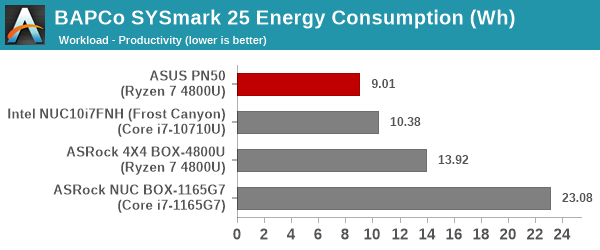
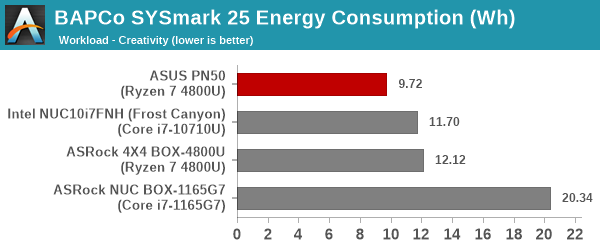
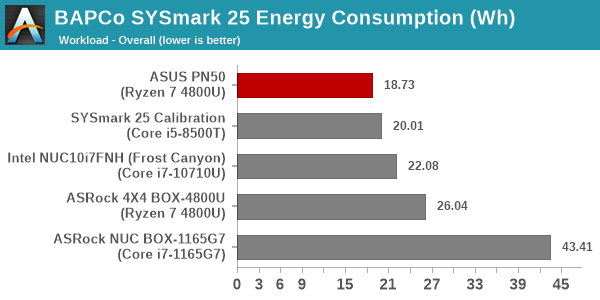
Thanks to the judicious choice of components (only 16GB of DRAM, and a QLC SSD), the energy consumption is the lowest of the lot for the ASUS PN50 across all workloads. Overall, the performance per watt metric presents an attractive picture of the system for the workloads in its target market.










32 Comments
View All Comments
Maksdampf - Saturday, October 2, 2021 - link
Beware! There is no such thing as a Ryzen 2 pr Ryzen 3, only Ryzen 2000 and Ryzen 3000, which are 14nm and 12nm Products based in Zen1 Architecture. I think what you mean is Zen3 or in Marketing terms Ryzen 5000 and Zen2 or in marketing terms Ryzen 3000 Desktop and 4000 Notebook series. Don't mix these terms as nobody will be able to understand you!brentpresley - Saturday, October 2, 2021 - link
Why review the PN50, when the PN51 is out with a Ryzen 5700U? I have both, and the PN51 is an incremental but welcome upgrade (2.5Gbs Ethernet, faster GPU, etc.)abufrejoval - Saturday, October 2, 2021 - link
I guess they can only review what they receive as a sample...The upgrade of the PN51 is unfortunately minimal, as it again the lesser Lucienne SoC (Zen 2) 5700U and not the faster Cezanne (Zen 3) 5800U. The biggest advantage seems to be better power management vs. the 4800U.
Also 2.5Gbit seems to be an option not built in by default. On the other hand USB3 2.5 Gbit Adapters are cheap and easy to obtain, just a bit more messy in terms of cabling.
fun_cheung - Friday, October 22, 2021 - link
I'd be interested in seeing some benchmarks on the 5800U as well. PN51 with 2.5GbE is tempting and so is the Gigabyte BRIX 5800U with 2.5GbEkapqa - Saturday, October 2, 2021 - link
Thank you for the interesting review!It seems however, that there is conflicting info on the Miscellaneous I/O Ports Present, it seems on the frontpage in the overview box it is mistakenly labeled as TypeA Usb 3.2 Gen 2, but probably should be USB 3.2 Gen1.
kapqa - Saturday, October 2, 2021 - link
would be nice to have the faster Type A USB 3.2 Gen 2, as also my Asrock A300 sports only Gen1.Oxford Guy - Saturday, October 2, 2021 - link
Did I miss it or was no information presented concerning noise?Decibels-per-watt, noise character, etc.
Oxford Guy - Saturday, October 2, 2021 - link
Extra-small PCs are a dubious proposition unless their small size is critically important.Otherwise performance-per-dollar, speed-per-watt, and noise efficiency are typically all drawbacks that the smaller form factor’s cuteness can’t justify.
nandnandnand - Saturday, October 2, 2021 - link
A well-designed mini PC ought to have low noise. Even if it has a fan, ~20-25 Watts isn't much. The 45W 5900HX and 65W 5700G can be stuffed into mini PCs, and Intel puts discrete GPUs in NUCs.Performance per dollar continues to be bad. Bad vs. a desktop, and I see 5700U laptop deals in the $650-750 range that compare well to either the barebones or configured price.
Oxford Guy - Sunday, October 3, 2021 - link
A larger box makes lower noise easier to achieve at any price point. Vertically-mounted low-RPM 120mm sleeve fans, for instance, are dirt cheap.